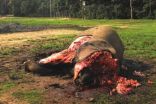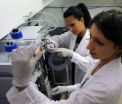(Press-News.org) Social insects, which usually have specialized behavioral groups (also called castes), are important models for social evolution and behavior researches. How division of labor in insect societies is regulated is an outstanding question and not fully understood yet. However, in many social insect species, experimental control over important factors that regulate division of labor, such as genotype and age, is limited. In a study published online on February 6th in Current Biology, researchers from Rockefeller University and BGI-Shenzhen have sequenced the genome of the queenless clonal raider ant Cerapachys biroi, a new model system to study the molecular mechanisms of social behaviors.
Ants of the genus Cerapachys are myrmecophagous and raid the nests of other ants. It belongs to the dorylomorph clade of ants, which also includes the infamous army ants. Since the early 1900s, introduced populations of C. biroi have become established on tropical and subtropical islands around the world, probably as a consequence of human traffic and trade. Like in many other army ants, colonies of C. biroi undergo two phases in their life cycles: one is for reproduction and the other for foraging and brood care. And more interestingly, colonies of C. biroi uniquely consist entirely of totipotent workers, all of which reproduce asexually.
The authors noted one of the most interesting findings of this study is that nestmates in a colony are almost clonally related and reproduce via an asexual way called automixis with central fusion, which was also found in the Cape honeybees. Asexual reproduction usually leads to loss of genomic heterozygosity, which is harmful in the long run. However, that genomic heterozygosity in C. biroi is lost extremely slowly. "It is not yet clear whether maintaining heterozygosity in C. biroi is through reduced recombination during meiosis, via selection against homozygous individuals, or both." said Dr. Peter Oxley, co-first author of this study, in Laboratory of Insect Social Evolution, Rockefeller University.
Nestmates of C. biroi can synchronously alternate between reproduction and brood care. The authors also found expression patterns of the genes associated with division of labor in other social insects are conserved in C. biroi and dynamically regulated during the colony cycle. "This suggests that the gene networks underlying reproduction and brood care in C. biroi are likely to be the same conserved networks underlying caste-specific behavior in other eusocial insects." said Dr. Daniel Kronauer, co-senior author of this study and head of Laboratory of Insect Social Evolution in Rockefeller University.
Because C. biroi colonies have totipotent workers and no queens, it is easy to conduct colony propagation and control the composition of arbitrarily sized experimental colonies. In addition, the colony cycle of C. biroi allows for precise selection of age-matched workers and experimental control over colony demography. "Ants represent one of the most successful exclusively eusocial insects, with at least 15,000 species have been recorded, they have evolved innumerous diversity. This is the fourth ant genome published in our group. The clonal raider ant is unique in many aspects compared to other ants. There are still many interesting questions related to the development and evolution of the queenless and reproductive cycle in this system that we don't know yet. The availability of this genome could pave the road for these future studies." said Dr. Guojie Zhang, co-senior author of this study, from China National Genebank, BGI-Shenzhen and Centre for Social Evolution in University of Copenhagen.
INFORMATION: END
The genome of clonal raider ant provides a promising model to study social evolution and behavior
2014-02-12
ELSE PRESS RELEASES FROM THIS DATE:
Common infections linked to stroke in children; vaccines may reduce risk
2014-02-12
Common infections are associated with a significantly higher chance of stroke in children, but routine vaccinations may help decrease risk, according to preliminary research (abstract 39) presented at the American Stroke Association's International Stroke Conference 2014.
"The protective association of routine vaccination against childhood stroke provides a widely available means of prevention, and this information can easily be dispersed by pediatric healthcare providers," said Nancy Hills, Ph.D., M.B.A., lead researcher and assistant professor of neurology at the University ...
More awareness, fast response key to combatting stroke in children
2014-02-12
Parents and healthcare professionals must be aware that children can have strokes and be prepared to respond to symptoms, according to research presented at the American Stroke Association's International Stroke Conference 2014.
As in adults, warning signs of stroke in children are: sudden weakness or numbness of the face, arm or leg; sudden difficulty in speaking; sudden problems in seeing; sudden difficulty walking; dizziness; or sudden onset of headache.
Researchers interviewed 28 parents whose child had a stroke about factors that contributed to delayed arrival to ...
Cocaine may increase stroke risk within 24 hours of use
2014-02-12
Cocaine greatly increases ischemic stroke risk in young adults within 24 hours of use, according to research presented at the American Stroke Association's International Stroke Conference 2014.
Ischemic strokes occur when a blood vessel supplying blood to the brain becomes blocked, preventing a continuous supply of blood to the brain.
"We set out to understand what factors contribute to stroke risk in young adults," said Yu-Ching Cheng, Ph.D., research scientist at Baltimore Veterans Affairs Medical Center and assistant professor of medicine at the University of Maryland ...
Weather changes may be linked with stroke hospitalization, death
2014-02-12
Stroke hospitalization and death rates may rise and fall with changes in environmental temperature and dew point, according to research presented at the American Stroke Association's International Stroke Conference 2014.
"Weather is not something people would typically associate with stroke risk; however, we've found weather conditions are among the multiple factors that are associated with stroke hospitalizations," said Judith H. Lichtman, Ph.D., M.P.H., study author and an associate professor in Epidemiology at the Yale School of Public Health in New Haven, Conn.
Researchers ...
Lost and found: New beetle collected by Darwin 180 years ago published on his birthday
2014-02-12
In 1832 Charles Darwin disembarked from HMS Beagle in Bahia Blanca, Argentina where he travelled by land to Buenos Aires. In Bahia Blanca, Darwin collected several fossils of large mammals along with many other living organisms, including several insects. More than 180 years later on Darwin's birthday, February 12, scientists name after him a long lost but new to science beetle genus and species from this collection.
The beetle was discovered and described by Dr. Stylianos Chatzimanolis, an entomologist at the University of Tennessee at Chattanooga, USA as a new genus ...
Use of mortality as measure of stroke care questioned
2014-02-12
A new study disputes the effectiveness of mortality as a measure of the quality of care provided by hospitals to stroke patients. The paper – which was simultaneously presented today at the International Stroke Conference in San Diego and published in the journal Stroke – found that use of do-not-resuscitate (DNR) orders differ widely between hospitals and that this variation can significantly skew a hospital's quality "ranking" based on mortality.
"With mortality increasingly being used as a marker for the quality of care provided to stroke patients, it is essential ...
"You hide it -- I'll find it!" -- Great tit has a bird's eye view when looking for dinner
2014-02-12
Birds that hoard food for a rainy day better be sure that there are no great tits around to spy on where they hide their reserve of seeds and nuts. So says Anders Brodin and Utku Urhan of the University of Lund in Sweden, who found that great tits can remember the position of such hideaways up to 24 hours after seeing it cached. Interestingly, even though great tits share this mental ability with well-known hoarders such as crows and jays, they do not store up food themselves. The findings appear in Springer's journal Behavioral Ecology and Sociobiology.
Observations ...
New data shows continued decline of African forest elephants
2014-02-12
London (February 12, 2014)—New data from the field in Central Africa shows that between 2002 and 2013, 65 percent of forest elephants were killed. They are being poached, for their ivory, at a shocking 9 percent per year.
This new data marks an update to an earlier paper in the online journal PLOS ONE on the status of forest elephants across Central Africa, published by the same scientists. Many organisations collaborated in the study which covered 80 sites, in five countries, over the twelve years of data collection.
The earlier paper, published in 2013, already had ...
Capillaries will measure diffusion and help in more efficient medical treatment
2014-02-12
How strongly do two dissolved analytes react with each other? Such information is of paramount importance not only in chemistry and molecular biology, but also in medicine or pharmacy, where it is used, i.a., to determine optimal drug doses. A method developed in the Institute of Physical Chemistry of the Polish Academy of Sciences in Warsaw will allow for determining diffusion coefficients of analytes in fluids and equilibrium constants of reactions – quickly, at low cost, and most importantly: universally.
In many medical therapies, a prerequisite for efficient treatment ...
Genetic find might lead to cattle that are more resistant to TB
2014-02-12
Scientists have identified genetic traits in cattle that might allow farmers to breed livestock with increased resistance to bovine tuberculosis (TB).
The study, which compared the genetic code of TB-infected animals with that of disease-free cattle, could help to impact on a disease that leads to major economic losses worldwide.
The research, led by the University of Edinburgh's Roslin Institute, has identified a number of genetic signatures associated with TB resistance in the cows that remained unaffected.
The study builds on previous research by The Roslin Institute, ...


